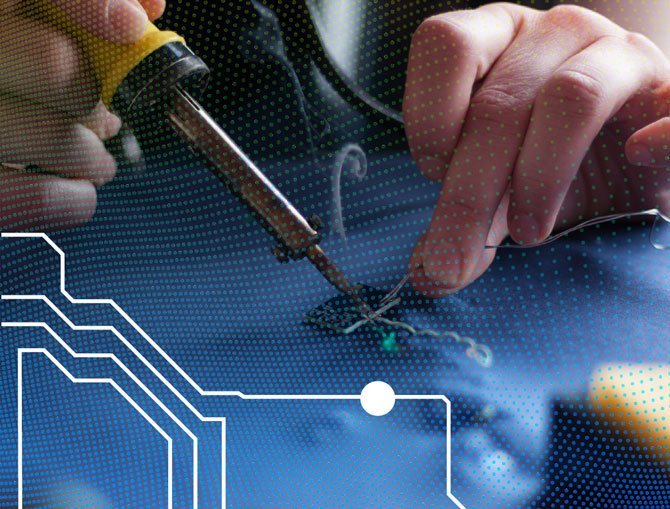

Electronic design is an ever-evolving field, and new technologies and trends are constantly emerging. Here at DSL we are always thinking about the future and how it may evolve further and as we look to the future we believe that there are several key trends that are poised to shape the way we design and manufacture electronic devices.
Miniaturization
Miniaturization is the process of reducing the size of electronic components, devices or systems. It is driven by the need for smaller and more portable electronic devices, as well as the desire to reduce costs and increase functionality. The miniaturization of electronic components and devices allows for the creation of compact and lightweight products that are more convenient for consumers to use and transport.
There are continuing advancements in microfabrication techniques and materials which have allowed for the creation of smaller and more efficient components, such as microprocessors, sensors, and actuators. As a result, electronic devices can now be made smaller and more powerful than ever before. No doubt, we will continue to see this trend result in even smaller devices as time goes on.
Examples can be found in a wide range of electronic products such as smartphones, laptops, wearables such at fitness trackers, medical devices, and even satellites. The miniaturization of electronic components has also enabled the development of new technologies such as the Internet of Things (IoT) and micro-electromechanical systems (MEMS) which are used in various applications such as healthcare, transportation and smart homes.
Miniaturization can also be used to improve the performance of electronic devices. For example, by reducing the size of electronic components, the distance that signals need to travel within a device can be reduced, which can lead to faster processing times and increased power efficiency.
Miniaturization is a key trend in electronic design, and it is expected to continue in the future as new technologies and materials are developed.
Internet of Things (IoT)
 The Internet of Things (IoT) is a network of connected devices that communicate with each other and with the internet. These devices can range from simple sensors and actuators to more complex devices such as smartphones, laptops, and home appliances. They are connected to the internet through wired or wireless connections and can be controlled and monitored remotely.
The Internet of Things (IoT) is a network of connected devices that communicate with each other and with the internet. These devices can range from simple sensors and actuators to more complex devices such as smartphones, laptops, and home appliances. They are connected to the internet through wired or wireless connections and can be controlled and monitored remotely.
Whilst it might sound incredibly futuristic, many homes across the UK already have at least one of these types of devices. Ever ‘asked’ Alexa to turn the music down or add something to your shopping list?
IoT devices are equipped with sensors and other technologies that allow them to collect and share data. This data can then be analysed and used to improve the performance of the devices and the systems they are a part of. For example, an IoT-enabled thermostat can collect data on temperature and humidity and then it will use that data to adjust the temperature in a room to optimize comfort and energy efficiency.
The IoT has the potential to revolutionize the way we live and work.
For example, it can be used to create smart homes, where appliances and systems can be controlled and monitored remotely. It can also be used to improve the efficiency of industrial processes, such as monitoring the performance of machinery and equipment. Additionally, it can be used in healthcare, transportation and many other industries for real-time monitoring and control.
IoT is a relatively new technology, and it is expected to continue growing in popularity in the future. As more devices are connected to the internet, the amount of data generated by the IoT will continue to increase. This will require the development of new technologies and platforms to manage and analyse this data, as well as new standards and protocols to ensure the security and privacy of the data.
It does throw up questions of personal privacy and data protection and it will very interesting to see how this develops as time goes on. But there is no doubt that it will contribute to shaping the future of electronic design in homes and businesses across the country.
5G and Edge Computing
5G and Edge Computing are two related technologies that are expected to have a significant impact on electronic design.
5G networks
5G is the fifth generation of mobile networks, which offers faster speeds, lower latency, and greater capacity than previous generations of mobile networks. It is designed to support a wide range of new applications and services, such as virtual and augmented reality, autonomous vehicles, and the Internet of Things (IoT). 5G networks will allow a much larger number of devices to be connected to the internet simultaneously, which will enable the creation of new products and services.
In essence it helps to support those electronic devices and the more they develop, the more support they require.
Edge computing
Edge computing is a type of distributed computing that brings computing resources closer to the edge of the network, where data is generated. This is in contrast to traditional cloud computing, where data is sent to a centralised data centre for processing. Edge computing is critical for 5G as it reduces the latency and ensures the efficient use of the 5G network.
It enables the processing of data close to the source, which reduces the need to transmit large amounts of data over long distances, which can be time-consuming and costly. This is particularly important for applications that require low latency, such as autonomous vehicles and industrial automation. By bringing the computing resources closer to the devices that generate the data, edge computing can help to reduce the overall cost and complexity of electronic design.
Involvement in electronic design
 When we look specifically at electronic design, 5G and Edge computing are expected to drive the development of new products and services, such as smart cities, Industry 4.0, and autonomous vehicles.
When we look specifically at electronic design, 5G and Edge computing are expected to drive the development of new products and services, such as smart cities, Industry 4.0, and autonomous vehicles.
As 5G networks are deployed, electronic designers will need to ensure that their products are designed to take advantage of the new capabilities offered by 5G, such as faster speeds and lower latency.
Additionally, electronic designers will need to consider how their products can be integrated with edge computing platforms to ensure efficient use of the network and reduce latency.
Artificial Intelligence and Machine Learning
Artificial Intelligence (AI) and Machine Learning (ML) are expected to have a significant impact on electronic design. These technologies can be used to improve the performance and functionality of electronic devices and systems, as well as to automate the design process itself.
One of the key ways that AI and ML can impact electronic design is by enabling devices and systems to learn from their environment and adapt their behaviour accordingly.
For example, an AI-enabled device could use machine learning algorithms to analyse sensor data and adjust its settings or behaviour to optimize performance. This could be used to improve the efficiency of industrial processes, such as monitoring the performance of machinery and equipment.
Another way that AI and ML can impact electronic design is by automating the design process. Machine learning algorithms can be used to analyse data from existing designs and identify patterns that can be used to generate new designs. This can be used to optimize the performance of devices and systems, or to generate new designs that are tailored to specific applications.
AI and ML can also be used to improve the security of electronic devices and systems by identifying and responding to potential threats in real-time. For example, an AI-enabled device could use machine learning algorithms to detect and respond to unusual network activity that may indicate a cyber-attack.
AI and ML can also be used to analyse data from electronic devices and systems in order to identify patterns and trends that can be used to improve their performance and functionality. This can be used to optimize the performance of devices and systems, or to identify new opportunities for product development.
Green Electronics
Green electronics, also known as sustainable electronics, refers to the design and production of electronic devices and systems that are environmentally friendly and have minimal impact on natural resources. The goal of green electronics is to reduce the environmental footprint of electronic products throughout their entire lifecycle, from the sourcing of raw materials to the disposal of end-of-life products.
There are several key areas where green electronics can impact electronic design. One of these areas is the use of environmentally friendly materials in the production of electronic devices. For example, electronic designers can use materials that are free of harmful chemicals, or that can be easily recycled or repurposed at the end of their useful life. This can help to reduce the environmental impact of electronic products and improve their overall sustainability.
Another area where green electronics can impact electronic design is in the design of electronic devices to conserve energy. This can be done by using low-power components, designing devices to consume less energy during use, and including power management features to conserve energy when the device is not in use.
It encompasses the concept of circular economy in electronic design, which is based on the principles of designing out waste and pollution, keeping products and materials in use, and regenerating natural systems. By designing products and systems that are easy to disassemble, repair, refurbish, and recycle, and by using materials that can be safely recovered and regenerated, we can promote circular economy as a part of green electronics.
The future of green electronics is expected to be shaped by advances in materials science, energy-efficient technologies, and innovative manufacturing processes. As electronic designers become more aware of the environmental impact of their products, they will likely incorporate more sustainable materials and designs into their products and use advanced technologies to conserve energy and reduce waste.
The Future of Electronic Design
The future of electronic design is filled with new technologies and new and continuing trends that have the potential to shape the way we design and manufacture electronic devices.
By keeping an eye on these trends, it allows our electronic design team to stay ahead of the curve and create devices that are more powerful, energy-efficient, and sustainable.
If you would like to discuss your next electronic design project then please contact DSL today to discuss your requirements.

